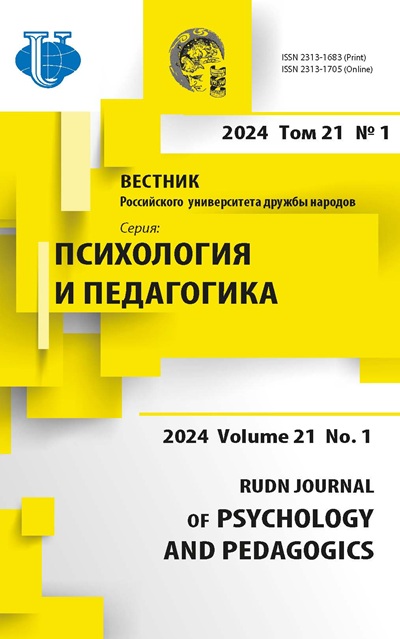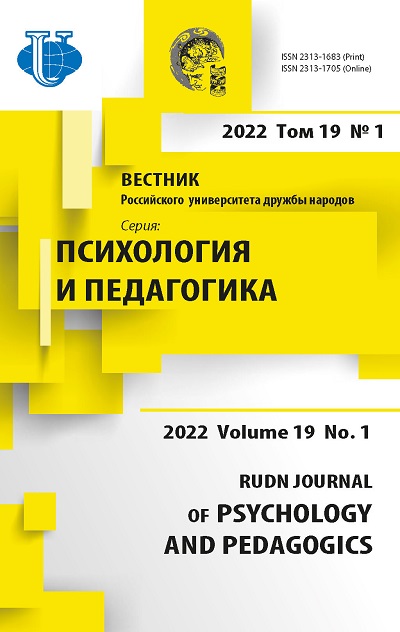Features of Group Identity and Its Relationship with the Level of Sports Achievements among Adolescents and Juniors Who Practice Boxing
- Authors: Sachkova M.E.1, Volkov R.S.1
-
Affiliations:
- Russian Presidential Academy of National Economy and Public Administration
- Issue: Vol 19, No 1 (2022)
- Pages: 54-70
- Section: PERSONALITY IN MODERN SOCIETY: ACTIVITY, IDENTITY, SAFETY
- URL: https://journals.rudn.ru/psychology-pedagogics/article/view/30740
- DOI: https://doi.org/10.22363/2313-1683-2022-19-1-54-70
Cite item
Full Text
Abstract
The present study is focused on identifying the features of group identity as well as the relationship between its components and the level of sports achievements in adolescents and juniors who practice boxing. The paper presents the results of an empirical study obtained on a sample of 360 young boxers (180 teenagers and 180 juniors). The respondents were divided into four groups by gender and age (15-16 years and 17-18 years), equal in number. The study used the Questionnaire of Social (Group) Identity by A.R. Graziani, M. Rubini, A. Palmonari, S. Costarelli, and R.M. Calla (adapted by O.V. Vaskova) and the technique for measuring the effectiveness of sports activities. Statistically significant differences in the parameters of group identity were identified, correlated with the gender and age categories of respondents. Higher indicators of group identity were found in female adolescents and juniors in comparison with male adolescents and juniors. The peculiarity of the age dynamics is that the components of identity increase in adolescent male boxers, while they may tend to decrease in adolescent female boxers. The hypothesis was confirmed that there exists a relationship between the indicators of group identity and the level of sports achievements in adolescent and junior boxers, but it was not only direct and positive. The article presents the prospects for future research on the meaning and role of social identity in the field of sports achievements.
About the authors
Marianna E. Sachkova
Russian Presidential Academy of National Economy and Public Administration
Email: msachkova@mail.ru
ORCID iD: 0000-0003-2982-8410
Doctor of Psychology, Professor, is Professor of the Department of General Psychology, Faculty of Psychology, Institute of Social Sciences
82 Prospekt Vernadskogo, bldg 1, Moscow, 119571, Russian FederationRoman S. Volkov
Russian Presidential Academy of National Economy and Public Administration
Author for correspondence.
Email: volkov.roman@inbox.ru
ORCID iD: 0000-0002-3737-3682
Postgraduate Student of the Department of General Psychology, Faculty of Psychology, Institute of Social Sciences
82 Prospekt Vernadskogo, bldg 1, Moscow, 119571, Russian FederationReferences
- Aranson, M.V., Ozolin, E.S., & Tuponogova, O.V. (2021). Gender limitations in women’s boxing sport. Teoriya i Practika Fizicheskoy Kultury, (2), 84–85. (In Russ.)
- Bairamov, V.D., & Alenurov, E.A. (2016). Specifics of group identity in the sports team. Human. Society. Inclusion, (2–1), 12–22. (In Russ.)
- Blodgett, A.T., Ge, Y., Schinke, R.J., & McGannon, K.R. (2017). Intersecting identities of elite female boxers: Stories of cultural difference and marginalization in sport. Psychology of Sport and Exercise, 32, 83–92. https://doi.org/10.1016/j.psychsport.2017.06.006
- Bruner, M.W., Balish, S.M., Forrest, C., Brown, S., Webber, K., Gray, E., McGuckin, M., Keats, M.R., Rehman, L., & Shields, C.A. (2017). Ties that bond: Youth sport as a vehicle for social identity and positive youth development. Research Quarterly for Exercise and Sport, 88(2), 209–214. https://doi.org/10.1080/02701367.2017.1296100
- Cameron, J.E. (2004). A three factor model of social identity. Self and Identity, 3(3), 239–262. https://doi.org/10.1080/13576500444000047
- Erikson, E. (2006). Identity: Youth and crisis. Moscow: Flinta Publ. (In Russ.)
- Fransen, K., Barker, J.B., & Slater, M.J. (2020). Leadership and social identity. In D. Hackfort & R.J. Schinke (Eds.), Routledge International Encyclopedia of Sport and Exercise, (pp. 219–231). London: Routledge. https://doi.org/10.4324/9781315187259
- Grebennikova, O.V. (2013). Group identity of present-day adolescents of 11–12: Specific features of growth in the socialization process. Sovremennaâ Socialʹnaâ Psihologiâ: Teoretičeskie Podhody i Prikladnye Issledovaniâ, (2), 73–82. (In Russ.)
- Kuzmin, M.U. (2015). Comparison of identities of junior pupils, teenagers and young people. Siberian Journal of Psychology, (58), 61–75. (In Russ.) https://doi.org/10.17223/17267080/58/4
- López-Gajardo, M.A., Pulido, J.J., Tapia-Serrano, M.A., Ramírez-Bravo, I., & Leo, F.M. (2021). Is perceived athlete leadership quality related to inside sacrifice and perceived performance in team sports? The mediating role of team identification. Frontiers in Psychology, 12, 662250. https://doi.org/10.3389/fpsyg.2021.662250
- Martin, L.J., Balderson, D., Hawkins, M., Wilson, K., & Bruner, M.W. (2017). Groupness and leadership perceptions in relation to social identity in youth sport. Journal of Applied Sport Psychology, 29(3), 367–374. https://doi.org/10.1080/10413200.2016.1238414
- Murray, R., & Sabiston, C. (2022). Understanding relationships between social identity, sport enjoyment, and dropout in adolescent girl athletes. Journal of Sport and Exercise Psychology, 44(1) 62–66. https://doi.org/10.1123/jsep.2021-0135
- Murray, R.M., Coffee, P., Arthur, C.A., & Eklund, R.C. (2020). Social identity moderates the effects of team-referent attributions on collective efficacy but not emotions. Sport, Exercise, and Performance Psychology, 9(3), 322–340. https://doi.org/10.1037/spy0000178
- Rees, T., Haslam, S.A., Coffee, P., & Lavallee, D.A. (2015). A social identity approach to sport psychology: Principles, practice, and prospects. Sports Medicine, 45(8), 1083–1096. https://doi.org/10.1007/s40279-015-0345-4
- Sachkova, M.E., & Vaskova, O.V. (2013). Interrelation of status differentiation and integration in student groups of senior adolescents. Social Psychology and Society, 4(1), 92–102. (In Russ.)
- Schinke, R.J., Ge, Y., Petersen, B., Blodgett, A.T., Dupuis-Latour, J., & Coholic, D. (2019). Building a national team context based upon the identity challenges and intervention strategies of elite female boxers in their home training environments. Journal of Sport Psychology in Action, 10(2), 94–105. https://doi.org/10.1080/21520704.2018.1543221
- Shapkina, E.V. (2008). Sociological analysis of sports team group identity. Belgorod State University Scientific Bulletin. Philosophy, Sociology, Law, (8), 221–232 (In Russ.)
- Sherif, M. (1956). Experiments in group conflict. Science American, 195(5), 54–59.
- Sidorenkov, A.V., Shipitko, O.Yu., Shtilnikov, D.E., & Stroh, W.A. (2019). Development of tools for the study of employee identity in the organization. Organizational Psychology, 9(3), 74–102. (In Russ.)
- Slater, M.J., Haslam, S.A., & Steffens, N.K. (2018). Singing it for “us”: Team passion displayed during national anthems is associated with subsequent success. European Journal of Sport Science, 18(4), 541–549. https://doi.org/10.1080/17461391.2018.1431311
- Sokhlikova, V.A., Romanina, E.V., & Baranova, V.A. (2019). Psikhologicheskie modeli uspeshnosti vystupleniya vysokokvalifitsirovannykh sportsmenov na osnove samootsenki i urovnya prityazaniya kak instrument optimizatsii protsessa sportivnoi deyatel'nosti. Resursy Konkurentosposobnosti Sportsmenov: Teoriya i Praktika Realizatsii, (1), 330–332. (In Russ.)
- Tajfel, H., & Turner, J.C. (1985). The social identity theory of intergroup behavior. In S. Worchel & W.G. Austin (Eds.), Psychology of Intergroup Relations (pp. 7–24). Chicago: Burnham Inc. Pub.
- Turner, J.C. (2010). Social categorization and the self-concept: A social cognitive theory of group behavior. In T. Postmes & N.R. Branscombe (Eds.), Rediscovering Social Identity: Key Readings in Social Psychology (pp. 243–272). New York: Psychology Press.
- Vaskova, O.V. (2013). A social identity questionnaire for diagnostics of socio-psychological characteristics of older adolescents student groups. Psychological Science and Education, 18(2), 87–96. (In Russ.)
















